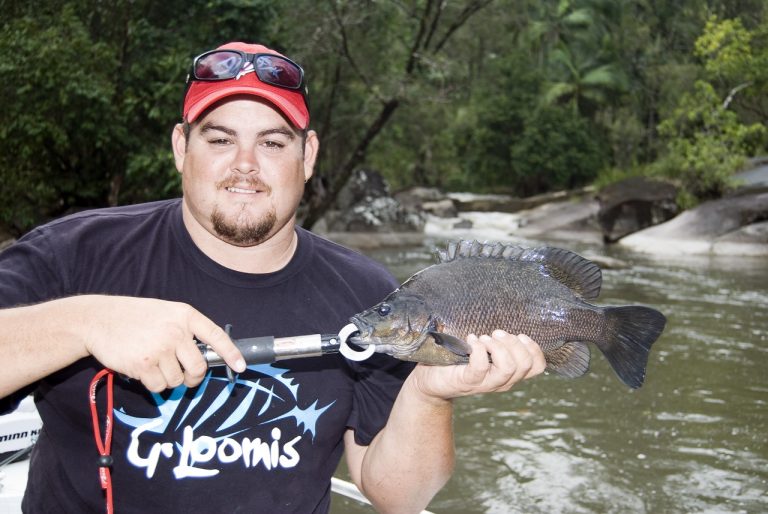Things to do in closed season
Picture: Cam Gow with a nice sooty from up a creek in Teemburra Dam
Well folks, with November we welcome a lot of things – afternoon storms, a cold beer after mowing the lawn, blow-up pools etc – but it also means that we say goodbye to chasing wild barra. With that in mind, I thought this week I’d give you a few options, and challenges, to keep you busy while barra are off the target list. Let’s get the ball rolling!
Number 1: Catch a grunter on a lure
If you haven’t already caught a grunter (a.k.a. javelin fish) on a lure, I suggest you devote some time to ticking this species off your list. They are not a species often considered as a luring target, yet they will readily take a soft plastic and are also occasionally taken on hardbodies. The key seems to be working rubble bottom in a deep hole or bend over the run-in tide, especially about half tide. Small plastics account for plenty and when coupled with light graphite spin tackle, you can have an absolute ball! These are a fish that loves to forage along the bottom, so work small curl tails or jerkshads with little hops and flicks along the rubble. Really concentrate on getting just the right weight jighead. You really need a natural, fluttering action because grunter are notoriously finicky. They can also bite quite softly at times and will often force you to allow them to take the plastic for a short run before striking to prevent them from spitting the hook. A soft, fast tapered graphite rod no heavier that 2-5kg is ideal. Use braid and leader as light as you feel comfortable with. Six pound braid and fifteen pound leader is ideal.
Number 2: Fish the sweet water run-off for sooty grunter
Most northern rivers have large populations of sooty grunter that, like barra, wait for the rains to arrive before breeding. This means that come the start of the wet season, small pools at the bottom of elevated streams become packed with these fish as they wait for water levels to rise and the influx in run-off to disperse their eggs. Once those first few storms arrive, these fish will school up in their hundreds and can be great fun for anglers flicking spinnerbaits and small diving minnows. Often these fish are preoccupied with breeding, so it can be necessary to provoke a bite by running your lure right past their nose. Don’t forget the impoundments either. Most impoundments have old creek beds which feed into their catchments and the sooties will push right up these into the headwaters too.
Number 3: Fish somewhere new
We often get stuck in a bit of a rut by only fishing the spots where we are confident and comfortable. Half the fun of fishing is the journey and there’s something special about visiting a creek for the first time and pushing ever further because you want to find out what’s around “just one more bend”. Even if it’s not a new creek, why not go on an exploratory mission up-stream and explore the headwaters of a creek you always fish the downstream side of? If you can get up to the brackish section, often this is a great way to target numbers of feisty mangrove jack and even jungle perch in more northern streams. This can be visual, visceral fun of the best kind!
Number 4: Fish a beach
If you’re like me, you cut your teeth fishing beaches in your younger days. I spent many afternoons after school flicking a little pink Manns 5+ around Blacks Beach and caught more than my fair share of flathead. Once I left school I purchased a pair of 10ft surf rods which I’d use at the end of the beach near the rocks for mackerel, trevally, parrotfish, cod and even one nice fingermark. To be honest, I haven’t used those rods in over half a decade, so my challenge to you and myself is to head to a beach for a flick one afternoon. Rocky beach heads, gutters and yabbie beds draw fish and hold fish at different stages of the tide. I like run-out tide for the gutters, as they act as tunnels which bait is washed through and I like the last of the run-in and first of the run-out for the headlands, as it means the maximum amount of depth around the cast-able structure.
Number 5: Take a newbie fishing
We often fish with our same group of friends and family and avoid taking along “greenhorns” because of the added effort involved in teaching them and having to fish to their skill level. Well, this closed season I challenge you to take a newbie for a fish. Think of it as an investment in next barra season. Take your wife, son, daughter, neighbour, workmate and teach them the basics of luring the snags. Sure there might be some lures in trees and it might be a little stressful, but remember, everyone starts somewhere. I personally recommend using weedless rigged soft plastics as they can cast them just about anywhere and nine times out of ten you’ll be able to get them back out.
Number 6: Plan a nocturnal assault
If you haven’t already, give one of your favourite offshore, or inshore, marks a go at night. Often a whole different variety of fish will be there waiting for you. For instance, one offshore spot where we regularly get mackerel, trout and cod during the day, holds fingermark, jew and grunter at night.
That’s just a few ideas folks. I guess the key is to challenge yourself. Do something different, fish somewhere new and never stop learning.
Fish hard and stay safe,
Lee Brake





